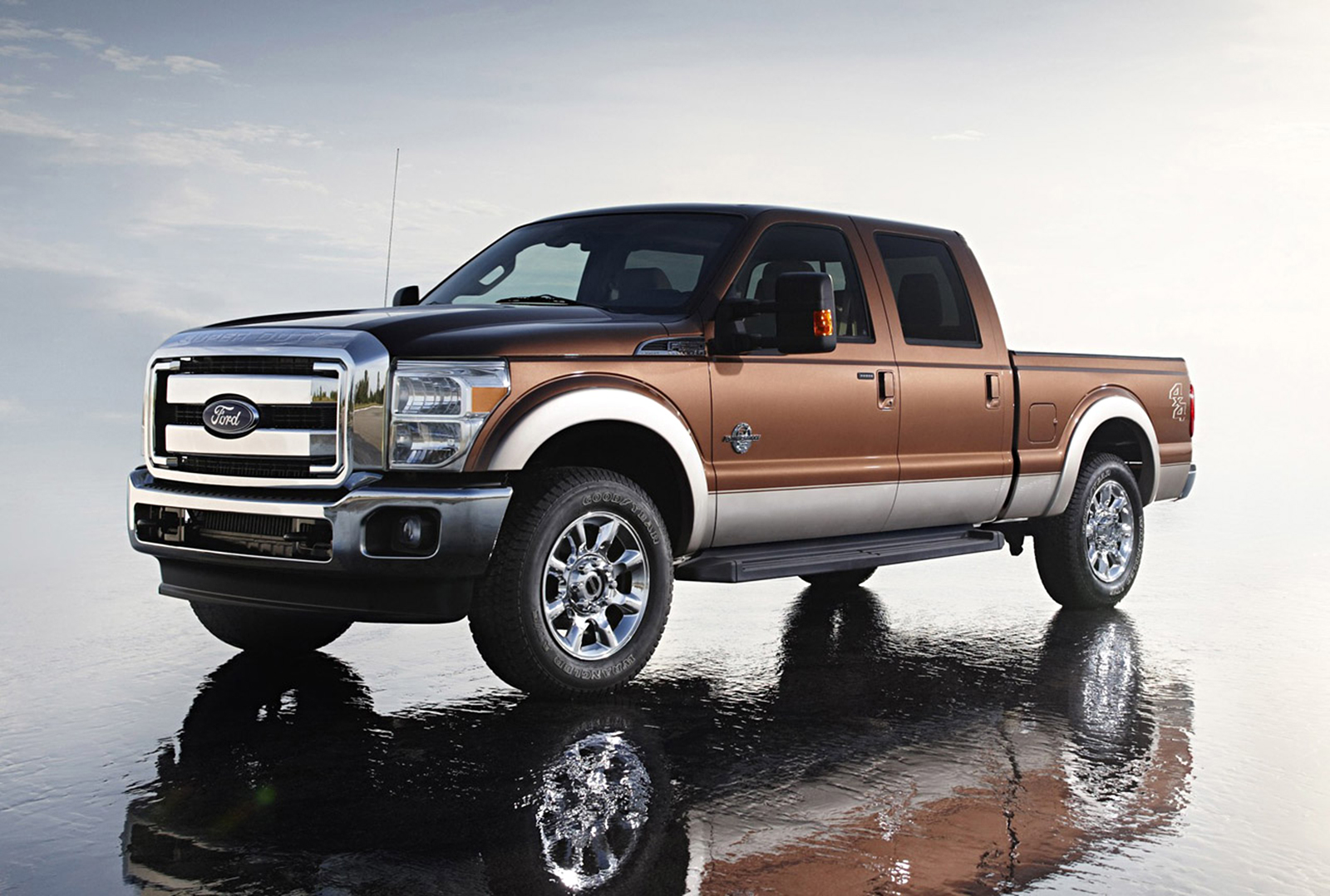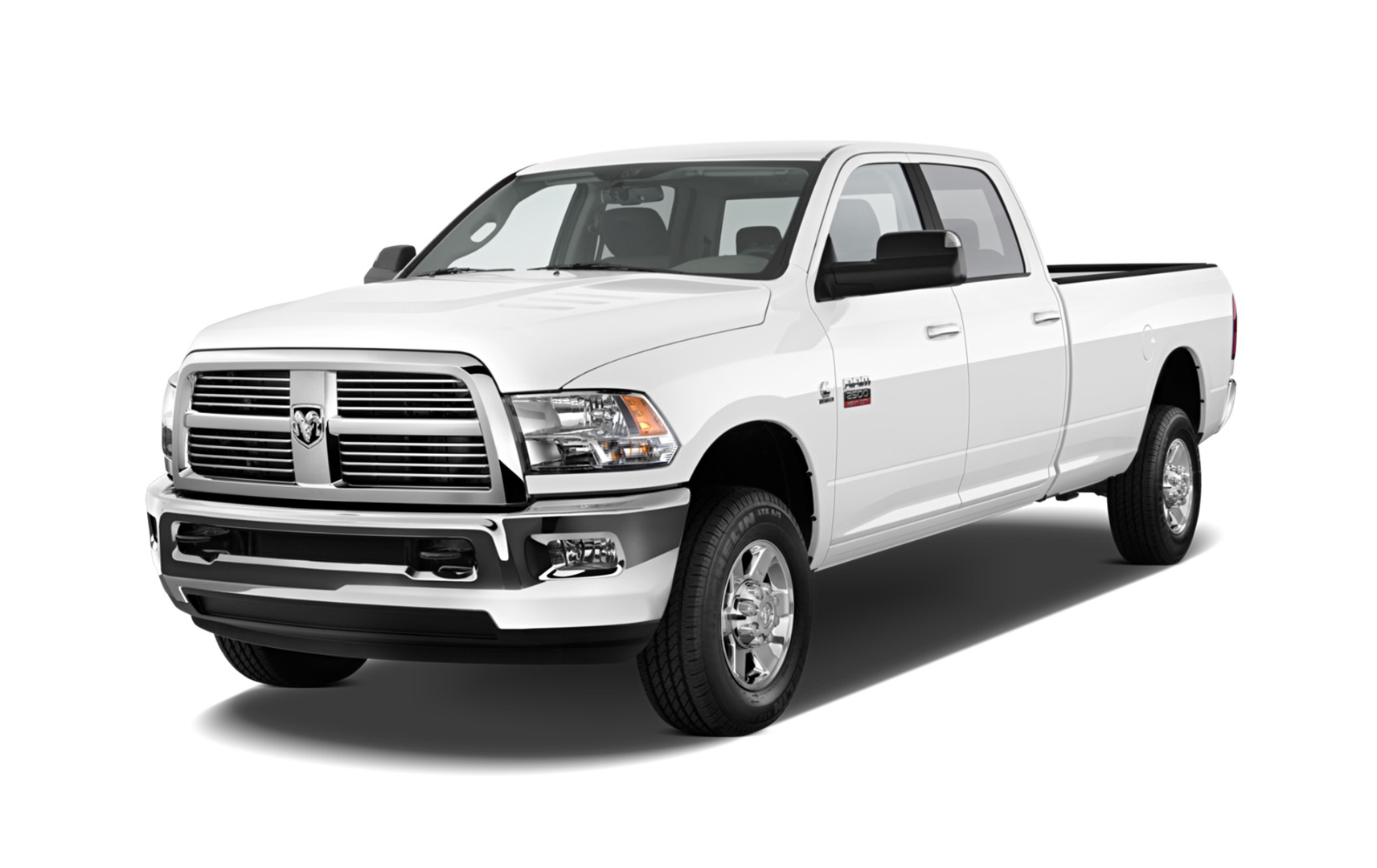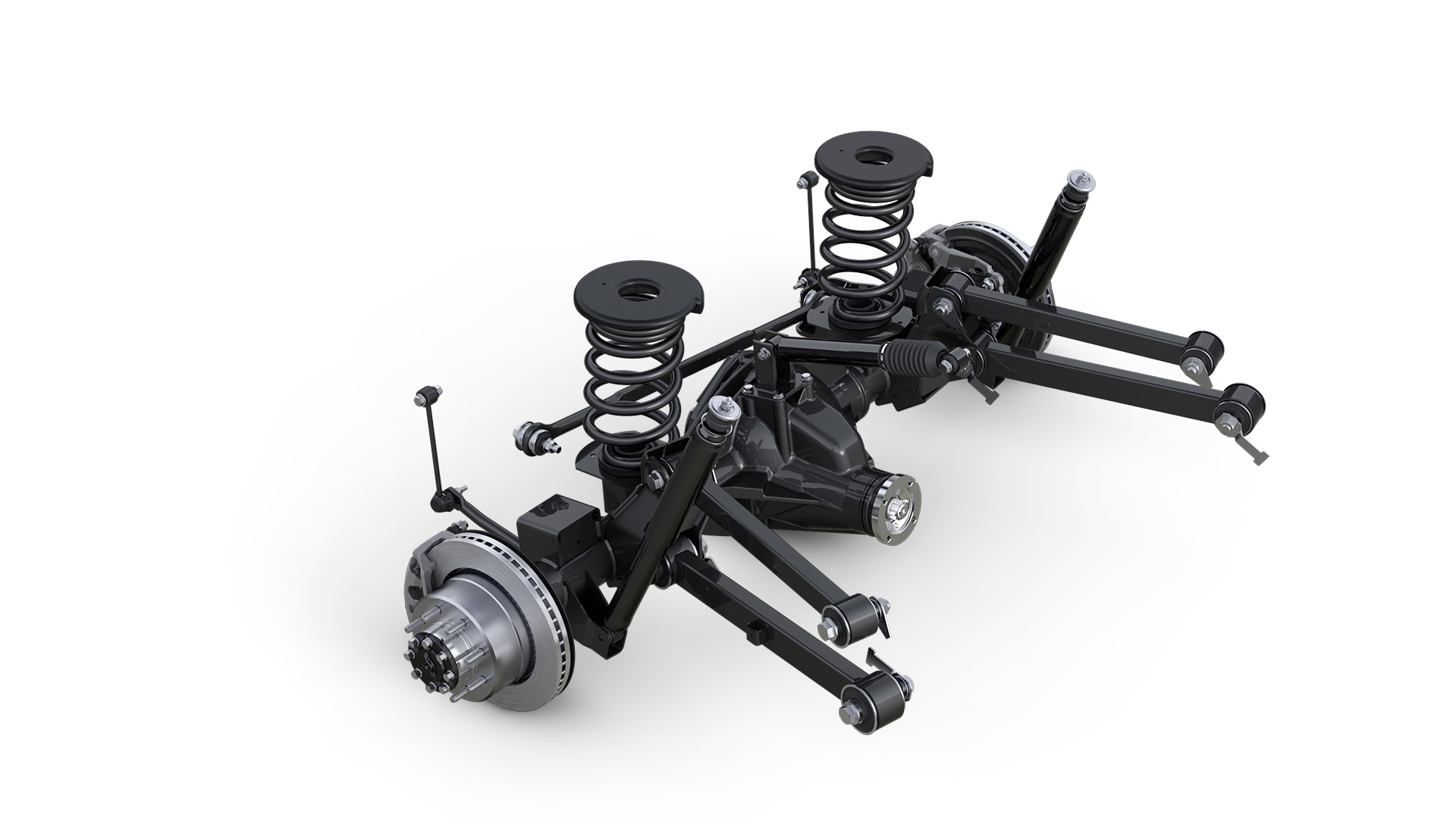We know diesels are expensive, but it’s a fact that 30K buys you a lot more capability in a truck than 20K does. For 30-large, you can break into the ’11-newer GM and Ford trucks, which thanks to their upgraded frames, suspensions and braking systems can out-tow and out-haul their predecessors by considerable margins. This is especially true for the ’11-newer GM heavy duties, which received a fully-boxed frame, a much beefier independent front suspension and steering system, asymmetrical rear leaf springs and larger brakes for the ’11 model year.
For Ford, the ’11 model year marked the debut of the 6.7L Power Stroke, an engine that left the factory with 400hp, 800 lb-ft and has since become renowned for its reliability and stump-pulling torque. Ford mated its all-new V8 to the six-speed 6R140 TorqShift automatic, a commercial-grade transmission that rivals the robust Allison 1000 found in GMs. Even though the Super Duty’s frame and axles were carried over from the ’08-’10 trucks, the rear 10.5 Sterling was treated to larger pinion bearings and up front a new TRW steering box incorporated a bigger sector shaft. The revamped steering system also led to less feedback through the steering wheel—a great feature while towing.
As for Ram, the new, fourth-generation body style was introduced in ’10, but the real magic began when horsepower and torque ratings began to increase starting in ’11. That year, a High Output version of the 6.7L Cummins bumped torque output to 800 lb-ft on trucks optioned with the 68RFE automatic transmission. Then in ’13, horsepower jumped from 350 to 370hp in the aforementioned configuration, while a 385hp, 850 lb-ft option became available for 3500 model trucks equipped with the new Aisin AS69RC automatic.
Although emissions system failures are still the biggest issue you’ll face with any modern diesel pickup, be it Ford, GM or Ram, it’s hard to go wrong with either brand built during this era. For 30K you’re getting a late-model truck packing 800 lb-ft of torque (give or take) for half the price of what it cost brand-new!
2012-2014 Ford F-250 Super Duty (60,000-145,000 Miles)

When Ford introduced the 6.7L Power Stroke in its revamped ’11 Super Dutys in the fall of 2010, the Blue Oval faithful held their breath. Many of them had spent the previous eight years enduring the many shortcomings of the Navistar-built 6.0L and 6.4L Power Strokes, so they had good reason to be concerned. However, now with eight production years under its belt, it’s widely accepted that the 6.7L is as stout as they come. Full disclosure: there were some valvetrain issues with ’11 model trucks (some of which dropped valves and needed completely new engines). However, Ford had everything ironed out by the time the 2012 models rolled off the assembly line in Louisville and all has been well ever since, which is precisely why we recommend you begin your search with ’12 trucks, and not ‘11s, just to be safe.
6.7L Power Stroke: The Torque Monster

Aside from sporadic emissions-system issues and the occasional turbo overspeed on ’11-’14 Super Dutys, Ford’s CGI-block, reverse flow aluminum headed, 406 ci, 32-valve, common-rail V8 is a rock-solid reliable engine in a world where diesels don’t seem to be as durable as they used to be. In fact, it might just be the most reliable of the bunch at the present time. Four-wheel drive ’12-’14 F-250 crew cabs are rated to conventionally tow 14,000 pounds, but the 6.7L Power Stroke is so chock-full of low-end grunt that it feels like you could easily pull twice that amount. The relatively small, single sequential Garrett GT32 variable geometry turbocharger lends itself to making gobs of torque down low (800 lb-ft at 1,600 rpm) yet still provides enough airflow up top to produce 400hp.
EGT Sensor Failure

While EGR issues are somewhat common on the 6.7L Power Stroke, exhaust after treatment system failures are the most frequent causes of down time. Specifically, the exhaust gas temperature sensors fail with alarming regularity—and there are four of them. They monitor exhaust temps before and after the diesel oxidation catalyst (DOC), after the selective catalytic reduction (SCR) process and after the DPF. When the PCM detects an EGT sensor failure (usually accompanied by a P2033 code), it believes the after treatment system is seeing too much heat and shuts the engine down or brings it to an idle-only status. With these sensors capable of failing in as little as 10,000 miles, it pays to learn how to change them yourself and keep one in the glove box.
Highlights:
- 6.7L Power Stroke has proven highly reliable
- 400hp and 800 lb-ft, stock
- Tremendous low-rpm torque for towing
- Robust, proven chassis for towing heavy loads
- Near-bulletproof 6R140 TorqShift transmission
- Integrated exhaust brake
- Integrated trailer brake controller
- SCR system (which requires diesel exhaust fluid) brings fuel economy back to pre-’08 levels (14-18 mpg empty)
Low Points:
- Factory (restrictive) turbocharger is prone to failure (especially with aftermarket tuning in the mix)
- Emissions-control systems such as EGR, DPF and SCR are a weak-link
- EGR-related issues typically arise after 70,000 miles and it’s common to need a new EGR cooler between 70,000 and 100,000 miles
- Radiators (both the primary unit and the secondary radiator) can leak
- Coolant leaks at the turbo are frequent occurrences
- Once out of warranty, injection system and emissions system components can be expensive to replace
2011-2014 Chevy/GMC Silverado/Sierra 2500 HD (95,000-145,000 Miles)

The ’11-later Chevy and GMC ¾-ton HDs represent GM’s aggressive plunge into the battle for towing supremacy. Its four-door, 4x4 2500 model trucks are legally capable of towing 13,000 pounds conventionally and 16,700 pounds (500 more than ’11-’14 Fords) by fifth-wheel or gooseneck hitch thanks to a host of chassis upgrades over ’07.5-’10 models. Among the key improvements that made it onto GM's ’11 trucks were a fully-boxed frame, beefier upper and lower control arms, bigger torsion bars, larger brakes and an asymmetrically designed rear leaf spring system for enhanced ride quality and to reduce the chances of axle wrap. All of these additions increased the curb weight, but the added heft in all the right places helped improve towing stability.
LML Duramax: Bells, Whistles and 765 LB-FT

As for the LML Duramax found in ’11-’16 GM HDs, this is the fifth rendition of an engine with the same overall architecture it possessed upon being introduced in 2001. However, for ’11, GM upped its output to 397hp at 3,000 rpm and 765 lb-ft of torque at a low 1,600 rpm. Bosch piezoelectric injectors and a CP4.2 high-pressure injection pump (precisely timed to both the camshaft and crankshaft position) are capable of in-cylinder injection pressures as high as 30,000 psi. The LML also features a factory-integrated exhaust brake similar to what you’ll find on ’07.5-newer Rams. While the LML’s exhaust brake functionality is nowhere near as aggressive as the Ram’s, it still makes a big difference in stopping power (not to mention it extends the life of the truck’s service brakes).
A Stronger Allison

To stand up to the extra 105 lb-ft of torque that the new LML Duramax dished out, the Allison 1000 was beefed up considerably for the ’11 model year. From front to back, the Allison was fitted with a dual-friction face torque converter that would spend a lot more time in lockup, larger lubrication holes in its front support and shafts, increased clutch count for better clutch-holding capacity, low-drag clutch packs to minimize spinning losses, a larger diameter output shaft and an oval-shaped tail housing on 4x4 models for added rigidity for both the transmission and the transfer case. In addition, the ’11-newer version of the Allison 1000 features variable main line pressure, electronically controlled by the transmission control module (TCM). This means that during instances of steady-state driving, line pressure is reduced to cut down on internal transmission temperature.
Highlights:
- LML Duramax is based on the tried and true 6.6L architecture introduced in ‘01
- 397hp and 765 lb-ft, stock
- New and improved version of the Allison 1000 six-speed
- Integrated trailer brake controller
- Integrated exhaust brake
- Beefier IFS and rear suspension systems
- Capable of 17-20 mpg empty
- Ninth injector injects fuel for regeneration downstream rather than in-cylinder (which was known to contaminate engine oil on ’07.5-’10 models)
Low Points:
- Emissions control components can be problematic (EGR, DPF and SCR)
- Emissions control and injection system parts can be expensive to replace
- The factory Bosch CP4 injection pump can fail at higher miles (and often takes out the injectors when it goes south)
- No fuel supply pump (lift pump) from the factory
- Low-slung, passenger side DEF tank is susceptible to damage when off-road
- DEF refills have to be performed under the hood (not next to the fuel door)
2010-2014 Ram 2500 (75,000-145,000 Miles)

A body style redesign highlighted the ’10 Ram 2500s, while a 150 lb-ft increase bumped the 6.7L Cummins’ torque rating to 800 lb-ft during the midst of the ’11 model year (68RFE automatic models only). The Cummins’ power output also picked up 20hp in ’13, bringing its automatic transmission-only rating to 370hp and 800 lb-ft. Even though the 3500 models were the first to receive the new 50 KSI steel frame in ’13, the new and improved frame (complete with hydroformed main rails, fully boxed rear rails and reinforced with eight separate cross members) became the foundation on 2500 models in ’14.
6.7L Cummins: Miscellaneous Subtle Changes

Outside of ECU programming and fuel system enhancements, very few internal changes have been implemented on the 6.7L Cummins since its inception. After adding SCR to the exhaust after treatment system in ’13, ¾-ton Rams saw a noticeable improvement in fuel economy over ’10-’12 models. While there were several power rating increases between ’10 and ’14, we wouldn’t shy away from a ’10 or early ’11 model Ram. After all, the aforementioned torque increase that occurred in mid-2011 was great for marketing, but engine dyno graphs show that the 800 lb-ft number is essentially a peak figure. Once torque spikes to 800 lb-ft at 1,600 rpm it immediately drops off, falling close to previous model year torque figures. In contrast, the ’10 and early ’11 Cummins mills turn out 650 lb-ft at 1,500 rpm and sustain it until 2,800 rpm.
Coil Spring Rear Suspension

In 2014, Ram introduced a bold new rear suspension option for its ¾-ton trucks. Influenced by the ride quality it yielded in the ½-ton segment, a five-link coil spring rear suspension replaced traditional leaf springs. Depending on who you talk to, some owners (mostly those concerned with ride quality) like it, while others (the heavy hauling crowd) wish they had a traditional leaf spring setup. Either way, the rear five-link coil spring suspension did not hamper payload or towing capability in any way. In fact, the coil springs are rated to tow as much as 17,940 pounds.
Highlights:
- 350hp and 800 lb-ft, stock (’11.5-’12 w/68RFE automatic)
- 370hp and 800 lb-ft, stock (’13-’14 w/68RFE automatic)
- Variable geometry turbocharger makes for instant transient response
- Factory (and highly effective) exhaust brake (with “Smart” mode added in ‘13)
- Factory-integrated trailer brake controller
- Proven Bosch high-pressure common-rail injection system
- Fuel economy improved in ’13 with the addition of SCR (the system that utilizes diesel exhaust fluid)
- Vast aftermarket support
Low Points:
- 68RFE automatic transmission is a weak link, especially if the truck is tuned
- Emissions control components can be problematic (EGR, DPF and SCR on ’13-’14 models)
- Moveable parts of the variable geometry turbo (and its VGT actuator) can be unreliable due to soot and carbon buildup
- Common-rail injection system components can be pricey, but injectors usually last 200,000 miles
- High-mile, tuned engines may pop the head gasket somewhere around 200,000 miles